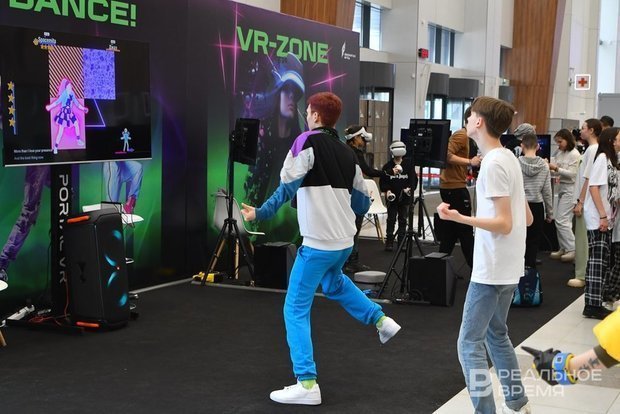Galina Akhmerova — about gamification as a way of dialogue with young people about important things

Modern motivation systems are based on an integrated approach. Therefore, with the arrival of a new generation of young people who grew up on video games on the labour market, many companies began to use elements of gamification in their work processes. Galina Akhmerova, CEO of Round platform, founder of Darwin Foundation for the Development of Accessibility of Modern Education, member of the Eurasian Association of Women Regional Leaders, member of the Interregional Association of Women's Business, writes more about this in the author's column for Realnoe Vremya.
Millennials and Zoomers are accustomed to video games since childhood. Therefore, the transfer of game mechanics fits seamlessly into the lives of new generations of employees.
According to a study by Kaspersky Lab, 83% of children over the age of 7 play online games in Russia. Almost one in ten of them devotes all their free time to this, and 47% — several hours a day. Game mechanics are clear and familiar to them.
But here I would like to point out that nothing new is actually happening right now. Gamification tools are as old as the world and are used both in pedagogy and in working with personnel. In the USSR, game elements were used to increase work motivation, a well-known example is the Stakhanovite movement. Honour boards, cups, insignia, certificates and commendations are still used in companies.
Nevertheless, gamification has been used as a full-fledged tool for development and training only in the last decade. Let's figure out how it works and what this human need to play games is based on.

Types of players
The most famous classification of players belongs to Richard Bartle, Professor at the University of Essex. It divides all people into the following types:
- Researchers who are attracted by the unknown.
Expanding borders, new countries, people, tastes;
- Achievers: collectors of achievements.
Lovers of collecting stamps, models, certificates;
- Killers: excellent students of this life.
It is important for such people to be the first: in the marathon, the Olympics, and necessarily at the stand “the best employee of the month”;
- Socialisers: communication is in their hands.
These people attach a stray kitten, want to help, and will be happy to participate in marathons and KVN.
Each type has its own motivation and its own tools.
Let's take a closer look at the game mechanics using the example of our free application “Round: from hobby to profession”.
In Round, the content is divided into levels: we set experience points for specific tasks. By completing them, the user receives points and game currency, which allows them to accumulate the desired goods in the internal store of the application (goods for the development of their hobby, meetings with experts, and more).
Developing in different directions, they receive digital awards — achievements.
By launching seasonal activities with a limited validity period, we close the need for competition: based on the results of participation, the application generates user ratings, in addition, we place exclusive gifts.
For socialisers, we have introduced a referral system “Invite a friend”: young people can attract new users by their personal recommendation code. After that, both users receive additional points. Such systems use banking applications.
Soft power in action
I believe that value motivation can be taught. Yes, it will come itself. But for the first touch, something pleasant and understandable for young people is important: first, material, maybe speakers, fitness watches, and then career meetings with representatives of companies.
This applies to us, adults, to say nothing of young people. The main thing is a properly constructed chain of events and actions, where gamification becomes an intermediate fixing element and leaves the result on the subconscious.

Gamification itself can be not only in the form of software. We implement its tools in the content as well.
Over 3 years of work, we have tested different hypotheses to understand what “works” and what does not. I think we can publish a collection based on our samples.
Now all our assignments are compiled according to a certain methodology (confirmed by the pedagogical department of the Kazan Federal University). In addition, we attract experts from the industry, from companies in the real sector of the economy. It is the combination of practice from enterprises, the right methodology and knowledge of formats that “come in” to teenagers that is our secret of high involvement of young people.
We turn to the “Knowledge — Action — Skill” approach and based on it we build the user's path: we look at a short instruction (micro-training) online — we do a task on it offline — we upload the finished project to our profile on the online platform. This is how we combine the youth's demand for modern technologies with the traditional approach of consolidating skills.
Gamification in processes
As another example, I will tell you how we tell the young people about professions within the framework of our PROinteres festival, which is currently being held in partnership with the Movement of the First.
The festival involves the release of a new profession every Monday. Classic marketing mechanics that fuels interest in the event from week to week with the question “What's next?".
A profession is a career track where tasks are presented in the chain “interest — educational institution — company”. Additionally, each task is assigned its own level of difficulty:
- + 200XP we test whether we are interested in it;
- + 300XP we study where one can study the chosen specialty;
- + 500XP we find out the company where such specialists are required.

All professions of this year have already been published. Among them: industrial designer, ecologist, telecom engineer, economist, food technologist, urban planner and others. We have collected the directions that are really in demand on the market to tell the young people that not only lawyers and programmers live well.
The festival partners shared their expertise in creating content for professions with us: Sber, SIBUR, Beeline, Samolet, KAMAZ PJSC, VTB Bank PJSC, Grid Company JSC, Tatneft PJSC, Kazan Fat Plant JSC, KAMA TYRES, Bank of Russia, UTEK-Regional Grids JSC. The experts involved will sum up the results: evaluate the projects of the young people in the following categories:
- 10 most active participants by rating;
- 36 winners in each task;
- 36 winners by likes “People's Choice Award”;
- 12 winners in the category “Mastering the Profession” — for those who complete all three tasks in each career track.
We also use gamification offline: our teams conduct intellectual career guidance games in the format of quizzes in educational institutions of the republic. Quiz is a modern quiz format, a game in teams. Usually the quiz consists of five or six rounds, which can vary. At the end, the winning team receives a gift.
The search for gamified formats will definitely lead you to classic interactive games. They are created by game technicians and methodologists. They can be compared with adapted game shows: 100k1, Pole Chudes, and others. They are actively used, for example, in camps.
We hold quizzes. A classic example of tours can be as follows: 1. Warm-up; 2. Text tour; 3. Graphic tour; 4. Audio tour; 5. All-in.
Gamification helps us to communicate with young people a lot. With its help, we really build a dialogue. And its instruments are so natural that they are unlikely to become mainstream (as representatives of the youth would say).
Reference
The author's opinion may not coincide with the position of the editorial board of Realnoe Vremya.